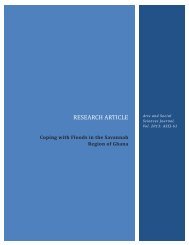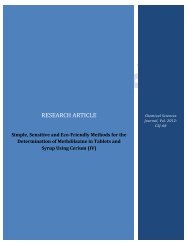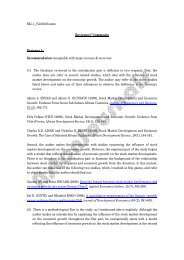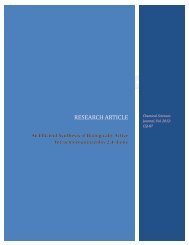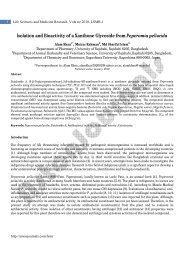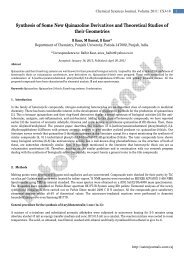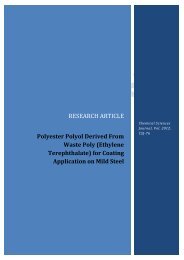Simple and Rapid Spectrophotometric ... - AstonJournals
Simple and Rapid Spectrophotometric ... - AstonJournals
Simple and Rapid Spectrophotometric ... - AstonJournals
Create successful ePaper yourself
Turn your PDF publications into a flip-book with our unique Google optimized e-Paper software.
6 Research Article<br />
3.2 Reaction mechanism<br />
In general, the intensely colored product formed between aromatic-NO 2 compounds <strong>and</strong> amine type Lewis bases<br />
may be attributed to the partial transfer of electronic charge (i.e., through overlap of orbitals of appropriate<br />
symmetry) from the Lewis base to the aromatic nucleus of the nitro-compound depleted off electron density,<br />
owing to the electron-attracting behaviour of the–NO 2 substituents. This phenomenon was named as chargetransfer<br />
interaction after Mulliken [34, 35]. Interaction between nitrophenols (PA, DNP) <strong>and</strong> amine of PPL may give<br />
rise to the formation of a Lewis salt where a proton is transferred from nitrophenols to the amine, as well as to<br />
charge-transfer interaction via partial transfer of charge from n-lone pair of the amine to the oxygen-π* of the<br />
nitro-group [36]. Modern underst<strong>and</strong>ing of CT interaction involves the partial transfer of charge from the Highest<br />
Occupied Molecular Orbital (HOMO) to the Lowest Unoccupied Molecular Orbital (LUMO) of the CT complex [37].<br />
Specifically, the nature of interaction between PA or DNP <strong>and</strong> PPL is presumed to be of charge-transfer type (i.e.,<br />
transfer of electronic charge from the amine donor to nitrophenol acceptors) as shown in Scheme.<br />
O<br />
OH<br />
N<br />
H2<br />
.Cl<br />
OH<br />
R 3 R 1<br />
O<br />
OH<br />
N<br />
H2<br />
.Cl<br />
R 3 OH<br />
R 1<br />
R 2<br />
Propranolol hydrochloride (PPH)<br />
PA orDNP<br />
R 2<br />
O<br />
OH<br />
N<br />
H2<br />
.Cl<br />
C-T complexation<br />
O<br />
R 3 R 1<br />
R 2<br />
C-T complex<br />
the measured species<br />
For PA: R 1 =R 2 =R 3 =NO 2 <strong>and</strong><br />
For DNP: R 1 =R 2 =NO 2 <strong>and</strong> R 3 =H<br />
Scheme: Proposed reaction pathway.<br />
3.3 Optimization of experimental variables<br />
Experimental variables which were found to affect the color intensity <strong>and</strong> stability of the resulting complexes were<br />
optimized to achieve maximum sensitivity <strong>and</strong> adherence to Beer’s law.<br />
3.3.1 Effect of reagent concentration<br />
The optimum concentration of the reagent required to achieve maximum sensitivity of the colored species in each<br />
method was ascertained by adding different amounts of the reagent PA or DNP to a fixed concentration of PPL.<br />
The results showed that 1.0 ml of 0.1% PA or 0.1% DNP solution was optimum for the production of maximum <strong>and</strong><br />
reproducible color intensity (Figure 3).<br />
3.3.2 Effect of solvent<br />
In order to select a suitable solvent for preparation of the reagent solutions used in the study, the reagents were<br />
prepared separately in different solvents such as 1,4-dioxane, chloroform, acetonitrile, acetone, t-butanol, 2-<br />
propanol <strong>and</strong> dichloromethane, <strong>and</strong> the reaction of PPL with PA or DNP was followed. The dichloromethane<br />
solvent was found to be the ideal solvent for preparation of both PA <strong>and</strong> DNP for method A <strong>and</strong> method B,<br />
respectively (Figure 4). Similarly, the effect of the diluting solvent was studied for both methods <strong>and</strong> the results<br />
showed that the ideal diluting solvent to achieve maximum sensitivity was dichloromethane in both the methods.<br />
http://astonjournals.com/csj



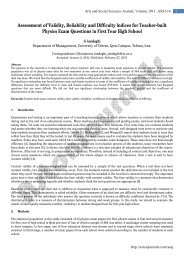
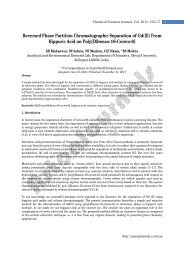
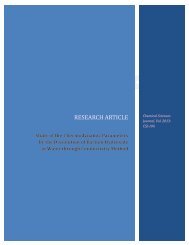
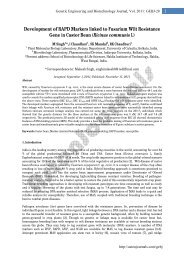

![[1,4]-benzodiazepine-2-one Derivatives as Potent - AstonJournals](https://img.yumpu.com/49117784/1/184x260/14-benzodiazepine-2-one-derivatives-as-potent-astonjournals.jpg?quality=85)
